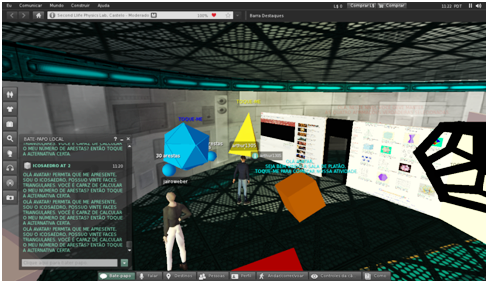artigo
Reality in virtual space: micro-worlds
for teaching geometry
 Reality
in virtual space: micro-worlds for teaching geometry
Reality
in virtual space: micro-worlds for teaching geometry. WEBER,
Jairo M.; dos SANTOS, Renato P. In: Proceedings of
the ESERA2013 - 10th biannual Conference of the European Science
Education Research
Association, September 2nd-7th 2013,
Nicosia, Cyprus. 2013.
Resumo
The purpose of this paper
is to
analyze how a microworld we have built in SL can help students in
building spatial geometry concepts about polyhedra within Papert’s
constructionist theoretical framework. It is a 3D immersive laboratory
with six rooms and interacting objects strategically arranged according
to the van Hiele levels. It gives feedback and encourages students’
progression through its levels, without emphasis on the assessment
tasks being completed. During the school year 2012, second and third
year students from two South Brazilian high schools participated in the
experiment. Here, we will analyze the interactions of one of these 26
experimental classes according to the van Hiele model of the
development of geometric thought.
download
Referências
- dos Santos, R. P.
(2012). Second
Life as a Platform for Physics Simulations and Microworlds: An
Evaluation. In: R.
PINTÒ; V. LÓPEZ; C. SIMARRO (Eds.), Proceedings
of CBLIS 2012 -
10th Conference on Computer-Based Learning in Science,
Barcelona, 26-29
junho de 2012. Barcelona: CRECIM -
Centro de Investigação em Ciências e
Matemática, 2012. p. 173-180.
- Papert,
S. A. (1980). Microworlds:
Incubators for
Knowledge. In S. A.
Papert (Ed.), Mindstorms - Children, Computers and Powerful Ideas (pp.
120-134). New York: Basic Books.
- van Hiele,
P. M. (1985). The Child’s
Thought and
Geometry.
In T. P.
Carpenter, J. A. Dossey, & J. L. Koehler (Eds.), Classics in
Mathematics Education Research (pp. 60-65). Reston, VA: National
Council of Teachers of Mathematics.
Voltar a Artigos Científicos.
Citar esta página:
dos SANTOS, Renato P. . In Física Interessante. 17 Jul. 2021. Disponível em: <>. Acesso em: .
Voltar ao começo
desta página
Voltar à página principal de Física Interessante


 Reality
in virtual space: micro-worlds for teaching geometry. WEBER,
Jairo M.; dos SANTOS, Renato P. In: Proceedings of
the ESERA2013 - 10th biannual Conference of the European Science
Education Research
Association, September 2nd-7th 2013,
Nicosia, Cyprus. 2013.
Reality
in virtual space: micro-worlds for teaching geometry. WEBER,
Jairo M.; dos SANTOS, Renato P. In: Proceedings of
the ESERA2013 - 10th biannual Conference of the European Science
Education Research
Association, September 2nd-7th 2013,
Nicosia, Cyprus. 2013.